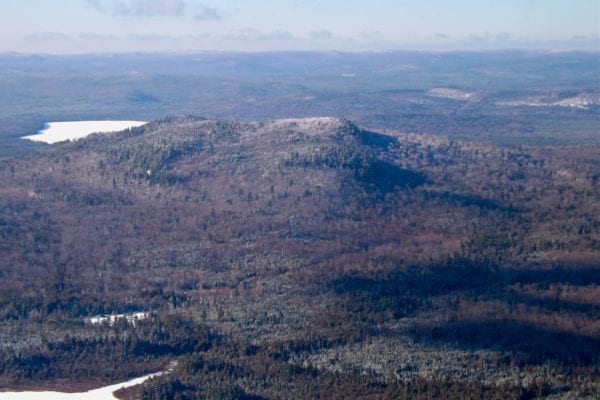Metal Mining in Maine: Environmental Risks
Mining is one of the most dangerous industrial activities. Mining metals in deposits with high levels of sulfides, which are common in Maine, is especially dangerous. Mining companies search for metals like copper and zinc in deposits where iron sulfide is present in large quantities. Iron sulfide creates acid when exposed to air and water. This acid kills fish and other aquatic creatures. It also leaches out toxic heavy metals, such as lead and arsenic, that may also be in the mined rock. These metals also harm fish, animals, and people.
Maine Passes Toughest Mining Law in the U.S. after Years of Discussions

Bald Mountain in Aroostook County
In 2014 and 2015, the Natural Resources Council of Maine (NRCM) fought weak Department of Environmental Protection (DEP) rules for metal mining in Maine. The Legislature rejected the rules with overwhelming bipartisan majorities in both years.
DEP designed the rules to help JD Irving, a huge Canadian conglomerate, blast an open-pit mine at Bald Mountain in Aroostook County. The ore at Bald Mountain is very dangerous because of its high levels of sulfides and arsenic. Mining pollution there would also threaten the Fish River, which is famous for its brook trout and landlocked salmon fishing. Although the Bald Mountain site is a particularly dangerous place for a mine, there are other known metal deposits in equally spectacular places, such as Moosehead Lake, Cobscook Bay, Penobscot Bay, and the Western Mountains. DEP’s proposed rules would have weakened protections against mining pollution in Maine in all of these areas.
Although the Legislature’s 2014 and 2015 rejections of weak mining rules were big wins for Maine’s environment, the battle to protect Maine from mining pollution was not over. DEP brought weak mining rules back for a third time in the summer of 2016. Once again, Maine citizens (including those featured in the videos below) turned out in large numbers to oppose the rules at the Board of Environmental Protection (BEP), which needed to approve them before they headed to the Legislature. Including those who submitted written comments, opponents of the rules outnumbered supporters 441-2, but the BEP approved the rules unanimously anyway.
As the Legislature started up in 2017, NRCM worked against DEP’s new rules. We also worked with Senator Brownie Carson (D-Harpswell) to draft a bill with the strongest protections against mining pollution in the United States, LD 820. The bill gained support over the course of the session and eventually passed with overwhelming bipartisan majorities, overriding Governor LePage’s veto.
Passing this law was NRCM’s biggest victory of the 2017 legislative session and a big win for Maine’s environment.
Some key provisions of the law and its accompanying strong rules are:
- a ban on open-pit mining
- a ban on mining in, on, or under public lands, lakes, outstanding rivers, coastal wetlands, and high-value freshwater wetlands
- a ban on mines that would require treatment of toxic wastewater in perpetuity
- a ban on tailings impoundments, the most dangerous parts of mines
- a requirement that mining companies pay enough money up-front to cover a worst-case mining disaster so Maine citizens don’t get stuck with cleanup costs for mining company messes.

Bald Mountain in Aroostook County
Maine needs the strong protections in the new law and rules because mining pollution is not a thing of the distant past, as the mining industry frequently claims. The Beal Mountain Mine in Montana, for example, leaked cyanide into nearby streams for years. This small, modern mine began operation in the late 1980s and closed in 1998 when its owner went bankrupt. So far, the federal government has spent about $10 million in taxpayer dollars cleaning up this site. The company’s $6.6 million reclamation bond is also gone. Estimated additional cleanup costs range from $25 million to $200 million.
Similarly, at the Summitville Gold Mine in Colorado, the mine began leaking cyanide in 1986, almost immediately after construction. The mine caused acid and heavy metal pollution in 1990 that “killed virtually every living thing in a 17-mile stretch of the Alamosa River." The owner went bankrupt and abandoned the site in 1992. So far, taxpayers have spent $200-$250 million to clean up the site. Water treatment and site management will cost taxpayers an additional $2.5 million every year in perpetuity. Maine cannot afford disasters of this magnitude.
In August 2014, disaster struck yet another modern mine, this time in British Columbia. The tailings dam at the Mount Polley Mine collapsed, leaching billions of gallons of polluted water and sludge into pristine salmon habitat. Imperial Mining Corporation built this mine in 1998.
Maine cannot afford any mining disasters. NRCM works to ensure that Maine State government enforces the law to the letter if any companies decide to develop mines here. If any mining companies move beyond exploration and apply for a mining permit, NRCM will work to ensure compliance with Maine’s mining law and rules, the toughest protections against mining pollution in the U.S.
Watch our short, one-minute video highlighting Maine farmers, sporting camp owners, and others who opposed the proposed metal mining rules for Maine in 2017.
Watch our seven-minute version of the above video:
Banner Photo: Aerial view of Pickett Mountain Pond, by J.Monkman/NRCM









